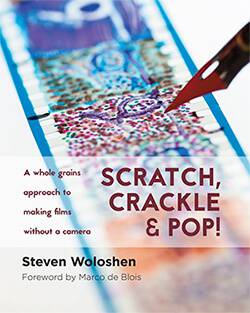Steven Woloshen’s ‘Scratch, Crackle & Pop!’ – Book Review
 Scratch, Crackle & Pop! A whole grains approach to making films without a camera
Scratch, Crackle & Pop! A whole grains approach to making films without a camera
Author: Steven Woloshen
Publisher: Scratchatopia Books
Steven Woloshen is a man with a mission, to keep alive the flame of what he himself concedes is a filmmaking medium with a limited lifespan. The reason is not out of technophobia or resisting the rise of digital processes, rather an unabashed joy for the process itself. Something I’m sure the luddites amongst us animators can relate to is the pleasure of the hands-on approach – sometimes for our own personal projects we’d rather fire up the lightbox than ToonBoom or Flash, or build an elaborate physical set from raw materials than construct it in CG. Perhaps the old-fashioned way isn’t always the most time or cost-effective, but if it makes the process itself more enjoyable then these are compromises we’re surely more than happy with.
Steven himself has taken this approach throughout his career as an animator who has managed to create an extensive filmography of work that remains, through expert use of music, timing and colour, accessible despite its experimental nature. A testament to this is the performance of his recent film 1000 Plateaus (2004-2014) having screened at major festivals including Annecy, Ottawa, Anima Mundi, Edinburgh and LIAF. As with much of his work, the film is created through the physical manipulation of film itself, a process he is keen to share with those curious about it in his latest book Scratch, Crack & Pop!
The three main areas of focus are consistent with the books title, being Scratch (scratching onto the surface of film), Crackle (transforming film by applying paints, inks et al) and Pop (the combination of both to inventive ends). To best serve these sections Steven examines his own back catalogue, grouping his work into relevant case studies for each. Each case study is presented with its own personal history, elaborating on which elements of each are unique to themselves; 1000 Plateaus, for example, began production on the passenger seat of the production vehicles during his stint as a driver on film sets. The variety of case studies also sheds light on the vast array of production materials films have made use of, including India ink, mapping nibs, found footage, cotton swabs, Letraset, carving knives, flashlights, adhesive tape and, in one instance, an unused compost bin (a breakdown of the materials required and the best means of sourcing them is subsequently provided).
Alongside the individual, case-by-case production breakdowns are instances of all-purposes advice regarding use of sound, lab conditions, the benefits of collaboration and the different behaviours to expect of materials when applied to film. The layout and presentation of the book is clear and the instructional elements read very well, with some additional treats in the form of an accompanying DVD compilation of the case study films and even two 35mm film strips to give readers a sense of what they will be working with should they be inspired to embark on their own project. For further inspiration a thorough appendix of recommended further viewing caps the book off.
Scratch, Crackle & Pop scratches an itch both for those curious about the mechanics of this particular branch of filmmaking and those who may be feeling drawn to creating work of their own that exists a world apart from the traditional or digital conditions they may be used to. Whether enabling a permanent shift of artistic direction or serving as a creative palette cleanser, it’s a proposition that holds appeal.
Scratch, Crackle & Pop can be purchased from scratchatopia.wordpress.com
To learn more about Steven’s work have a watch of our recent Lightbox video interview:

